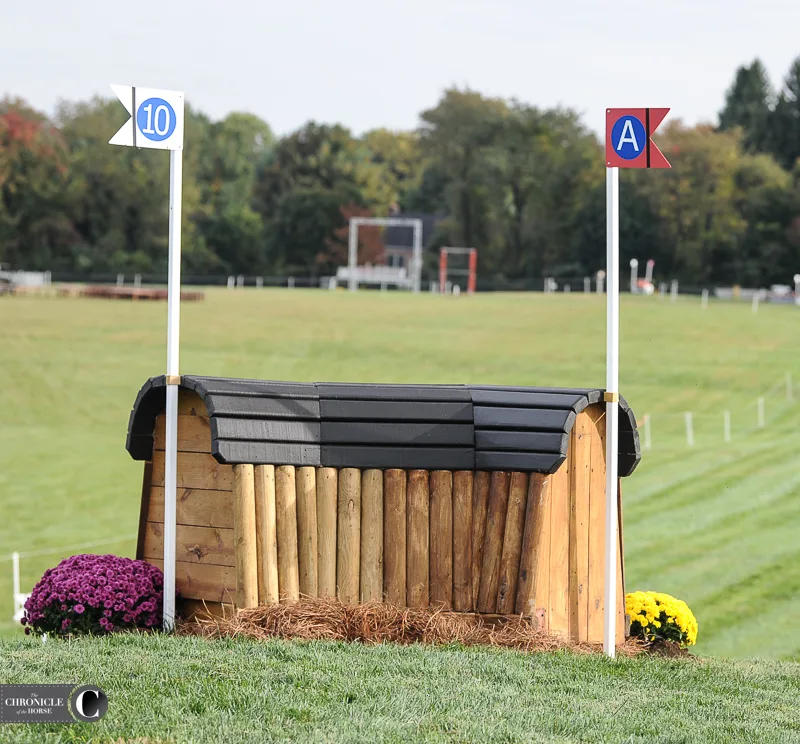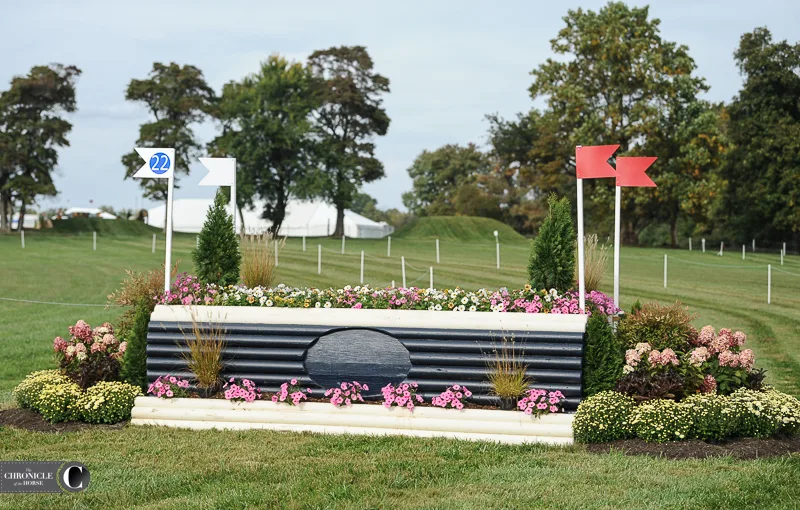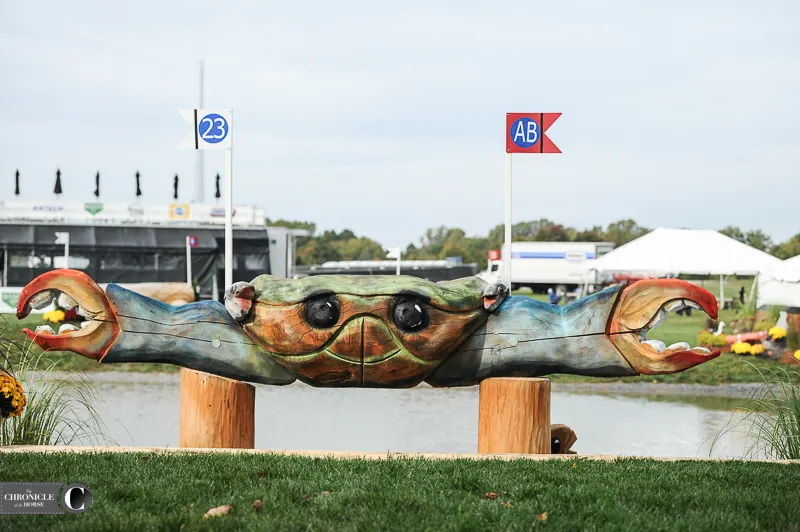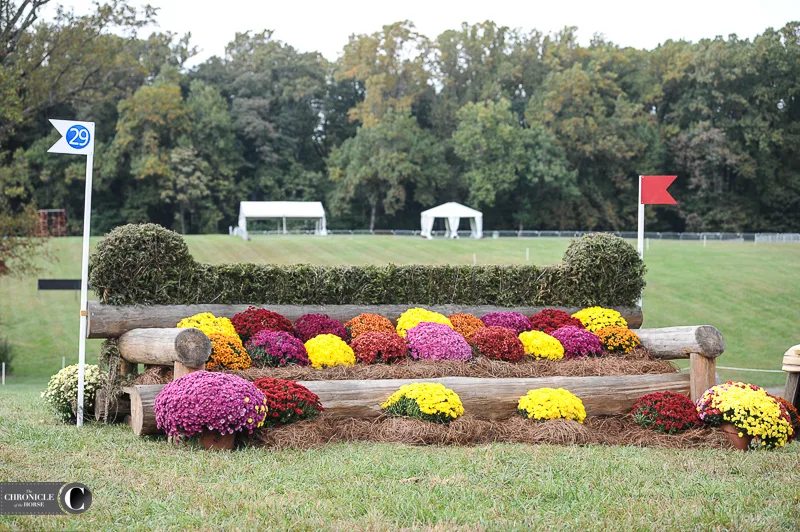Elkton, Md.—Oct. 13
In his second year as course designer for the Mars Maryland 5 Star, Ian Stark has traded last year’s challenging uphill pull to the finish for a track with proper five-star dimensions all the way to the end.
Stark moved the start/finish flags to a different part of the property to avoid finishing uphill and give a better flow to the 11 minute, 30 second track. But with a year under his belt to learn how the venue’s hilly terrain would affect the five-star horses tackling it, he’s come back with a course that asks more of them in its second half. (Check out an interactive course map here.)
“It was a fair climb last year at the end of the course, and some horses finished really well, but some were really toiling at the end,” he said. “For me, the whole flow is better, and it’s allowed me to keep the five-star standard all the way around. I felt that last year I had to back off a little bit, and it was almost three-and-a-half- or four-star on the way home. There was still technical difficulty, but I felt I couldn’t give the five-star dimensions on the big spreads because the horses were getting weary.”

Course designer Ian Stark has put the start and finish in a different place this year. Lindsay Berreth Photos
Liz Halliday-Sharp, who is in third-place after dressage on Cooley Quicksilver, called it “a very different track, kind of old school in places, which isn’t a bad thing.”
“It’s a real five-star, and it’s very challenging at the end,” she said. “I think [Stark’s] asking a lot of tired horses, so that’s going to be really staying on the ball all the way to the end. Just keep them with you. That will be very important. It’s definitely a different feel than the other five-stars. Each one has its own piece to take away, and I feel like there’s something to learn from everything.”

Fence 4AB, the Select Event Group Oriole Dew-pond. Stark said riders should jump them straight on and accurately. Cutting them too much might cause a horse to leave a leg.
The galloping fences at the beginning of the course include a big trakehner at Fence 2, the Crescent Chasm, which is unusual for a second fence.
“I had planned to have it in the warm-up area, but when I walked from the start box, I decided it was in the way, so it became No. 2,” Stark explained. “Some of the riders were concerned, but to me, it’s just an inviting, kick-on fence.”
The combinations start coming at Fence 4AB, the Select Event Group Oriole Dew-pond, and Fences 6 and 7AB, the Cecil County Economic Development Roll and the Cecil County Tourism Combination, and 8AB, the offset Delaware Paul Bunyan’s Tables.
The first major question comes at Fence 10ABC, the Mane N’Tail Singerly Slide, a very large rolltop with a steep downhill landing to a choice of ditch-and-brush skinnies. The left brush is the direct route. It will be five strides down the hill, then three strides to the narrow brush.
Stark put some trees and pumpkins in the way to stop people from mixing it up with the B option. There’s an ABC long route and ABC short route. (Be sure to stop and see the dinosaurs near the fence, which Stark says “have absolutely nothing to do with the course.” He found them at a garden center down the road and decided he wanted them.)
The Brown Advisory Inner Harbor, Fence 11ABC, is a bit different than last year, with the first boat a drop into water now instead of being in the water.
Horses will land and take four strides to a boat in the water, then three strides to a lifehouse out. There’s an alternate for the B element if they scramble on landing from the drop in.
Competitors then have several massive galloping fences before it’s time to refocus and set up for the coffin at 15ABC, Bodgie’s Hill & Dale, named in honor of longtime Fair Hill volunteer and supporter Bodgie Read, who died last year. It’s an open frangible log to a ditch to a skinny on a mound.
ADVERTISEMENT
“If you don’t set the horses up, you’ll be flying through there, and they’ll probably dislodge the MIM clip on the first fence,” Stark said. “I’m expecting them to be really good at the coffin.”
There’s no let up before Fence 16ABC, Baltimore’s Barricades. If you are visiting the site in person, make sure to walk up to these if you get a chance to get a sense of their size.
Two tables on three strides lead to a left-handed corner four strides away, but it’s all in a fairly straight line. There’s also a right-handed corner as an option.
“Tyson [Rementer], who built these for me is saying he’s been having sleepless nights about these tables because he thinks they’re huge,” Stark said. “I think it’s great. What I really want to do is stand on the landing side just to get a photograph of the expression of the riders’ faces. It’s maximum height and spread and looks like a tree.”
From there, competitors have a few more fences—the Dubarry of Ireland Stick Pile at 17, the upright Maryland Timber Rails at 18AB, a nod to the state’s timber-racing history, and the Visit Harford Winners Podium at 19—before they are back to the water.
Fences 20 and 21, the Sport Corp Corners, are set up at a water feature previously used for the Young Event Horse classes. Riders won’t be jumping into water, though. Instead, Stark has built two open corners—”they’re pretty huge,” he said—on the edges of the water that look intimidating, but should ride in a S-curve, coming from the left to the first one, then bending right to the second one.
As of Thursday night, he was waiting for seven truckloads of water to raise the water level up closer to the ground line.
“I don’t think they’ll cause a problem, but if we have an issue, they’ve got my favorite, the owl holes, as options,” referring to brush fences built for last year’s five-star.
Once the corners have been navigated, competitors have one gallop fence at 22 before facing the infamous “crab water.” Formally called the Mars Sustainability Bay, Fences 23AB and 24ABC pose a big test in the last quarter of the course. Crowds will be thick around this popular water feature, and the question has been turned around from last year, with horses asked to jump the famous crab from a mound.
“The horses can’t see what they’re jumping until they run up that steep ramp,” Stark said. “They’ve only got a couple of strides to assess the situation, which is a big drop looking straight into the Mars sponsors tents. It’s at 9 ½ minutes, which is quite far on for a big water combination.”
There’s a ramp landing to make it regulation height, then they have enough time to get reorganized, jump up a bank, bounce over a log and then a tight three strides to a brush. There’s also a long route in case horses are starting to get fatigued.
Lauren Nicholson, who is riding her sixth-placed finisher from 2021, Landmark’s Monte Carlo, called the course “tough” and anticipated the pull up to the big water could catch some horses out.
“[The course] gets them into a rhythm and gives them a lot of time to get them into a rhythm before it starts throwing stuff at you. But it’s proper,” she said. “I think it gets a bit more intense as it goes on, and I think it lures you when you go through the coffin field and kind of gallop up the hill for a really long time knocking off gallop fences.
“I think they’ll get a little shut off because they’re going to get a little bit tired, then you have a really intense section at the water at the top of the hill,” she warned. “I think it will be easy to go to sleep a bit there and get caught out.”
ADVERTISEMENT
Riders will head down the hill and jump the formidable Foxcatcher Ditch at 25, which was a corner last year.
“This is four fences from home, and the corner was too big a question at this stage,” said Stark. “On the approach there are trees on the right and left to get horses on the line. The horses have got to be honest and stay straight, but I’ve taken a lot of the guesswork out of it and tried to keep them on the right line. It’s up to them to get the right striding.”
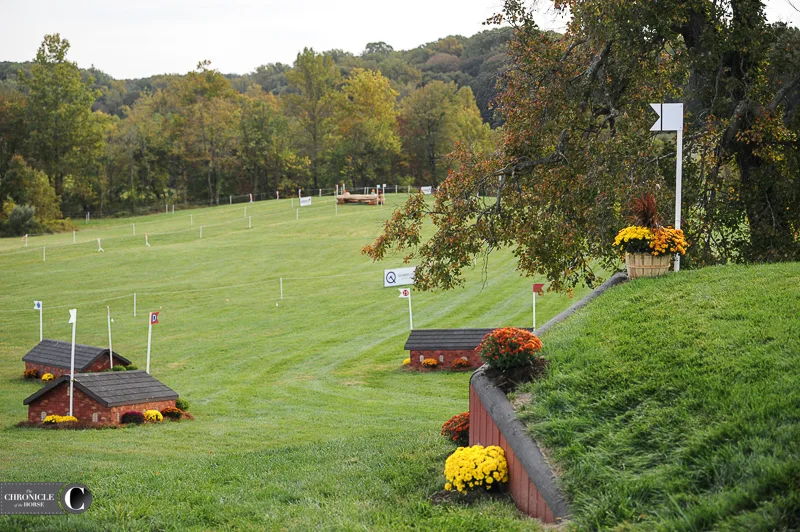 The County Fair Rollercoaster and Fair Hill International Drop, fence 26AB, will be a popular site for spectators. A beautifully built rollercoaster fence leads to a huge drop. On the landing side, there are two angled cabins, Fences 27 and 28, the Quarry View Building Group Warehouses. Stark numbered them separately in case riders need to take a longer route so they can get home.
The County Fair Rollercoaster and Fair Hill International Drop, fence 26AB, will be a popular site for spectators. A beautifully built rollercoaster fence leads to a huge drop. On the landing side, there are two angled cabins, Fences 27 and 28, the Quarry View Building Group Warehouses. Stark numbered them separately in case riders need to take a longer route so they can get home.
“It depends on how they drop off what striding they’re going to get,” he said. “I’m hoping they’ll jump off the right side as they’re approaching the turn to the first one, and then turn in the air to the second one. If they’re trying to go too straight, I think it’s a big ask. They had to decide what their horses are capable of and what they see in their own eye and point of view.”
Will Coleman will ride Dondante, who completed here last year but was tired toward the end of the course. Coleman said the terrain at Fair Hill is on par with the toughest in the world and feels the course is bulked up from last year.
“[The five-stars] all have their own feel, and this is like a cross between maybe a Kentucky and a Burghley [England],” he said. “In a weird way, I think the terrain here is very, very challenging. While Burghley is still probably the most intense five-star track, I think you’re going to continue to see this one go in that direction.”
Coleman thinks the first loop will be good for getting horses and riders in a rhythm and shouldn’t take too much out of them on the fairly flat going in the first four to five minutes.
“The crab water at 10 minutes looks like a lot of jumping on horses that are for sure going to be feeling the effects of what they’ve done,” he said. “I think it’s one of these courses that could have a cumulative effect. It does leave quite a lot for the end, which you could see silly mistakes of horses and riders just being slightly switched off or fatigued.
“It’s not a super technical track on presentation, but the terrain and the conditioning and what that’s going to feel like the last two or three minutes—I think it’s going to require really good cross-country riding,” he added. “It’s a very fair presentation to the horses—there’s no tricks—but I think you are just going to have to be riding what’s underneath you.”
Check out what you need to know here.
COTH’s Coverage I Results I Schedule
We’re on site all week to bring you news, photos and interviews from the country’s second five-star event. Check back at coth.com all weekend and be sure to pick up the Nov. 7 print edition of The Chronicle of the Horse for more.

